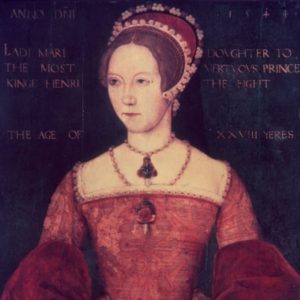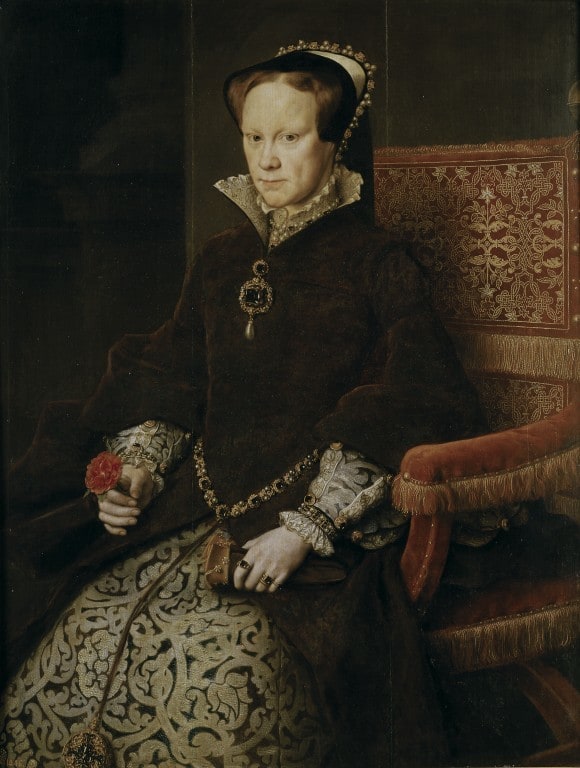History has not been kind to Queen Mary I of England. She has a famous drink named after her of course, but in 2016, it’s unlikely that many know much more about her. What some might know is never positive. “Wasn’t she the crazy Catholic ruler who burned heretics at the stake?” Well, those interested in learning more about her besides the burnings (which many a ruler sanctioned in the day) should pick up Linda Porter’s The Myth of “Bloody Mary“. Porter’s biography of Queen Mary takes the reader into a fascinating period of England’s history by giving a fresh assessment of a complex queen, whose fierce loyalty to her mother, her faith and her country should be admired.
Mary was the daughter of King Henry VIII and the Spanish princess Catherine of Aragon. (For an excellent biography of Catherine, read Giles Tremlett’s Catherine of Aragon: The Spanish Queen of Henry VIII.) It was the truly awful King Henry, the power-hungry, obese, lust-driven despot who initiated the destructive process of ripping this devoutly Catholic kingdom from the hands of the Bishop of Rome forever. The definitive break required the combined efforts of his Protestant son, Edward VI, and Protestant daughter (by his second wife Anne Boleyn) Elizabeth I. But it was Henry who lit the match. And it was Mary who, despite incredible pressure as a young princess, remained a loyal Catholic and who, during her relatively short reign, desperately tried to wrench her kingdom and nation away from the clutches of Protestantism. In the end, those efforts failed. Without an heir, Mary was succeeded by her crafty half-sister Elizabeth, who enjoyed an incredibly long reign, which allowed her to reverse Mary’s reconciliation with Rome. It’s fascinating to ask what might have been had Mary given birth to a son, or daughter.
The victors always write the history books from their perspective, and so the anti-Catholic, Protestant establishment in England under Queen Elizabeth did their best to portray Queen Mary as a horrible, blood-thirsty tyrant who was obsessed with returning England to the servitude of the pope. Porter’s book gives the reader a more favorable and balanced look at this widely misunderstood, flawed, but admirable queen.
Mary’s life-long devotion to Catholic liturgy is singled out for special attention in Porter’s book. Writing about the efforts of Mary’s anti-Catholic half-brother Edward and his minions to undermine the Catholic mass, Porter writes:
But Mary was devoted to the Mass, a ceremony central to her daily life. She already knew she would never give it up, even if it meant public opposition to the laws being made in her brother’s name. . . . She embraced it [mass] almost ostentatiously, hearing four masses a day as early as 1547. . . . But more than anything else, she hated them [the reformers] for their commitment to the communion in both kinds and their assertion that nothing miraculous happened when the host was elevated and the priest received the body of Christ. Doctrinal arguments she eschewed, but the Latin mass and its central mystery were her chief points of reference in an uncertain world. She would not yield on them.
Later as queen, Mary worked tirelessly to restore Catholicism to everyday life in England. Despite the damage done by her father and half-brother, England still was predominantly a Catholic country. But Mary understood, like Erasmus and Thomas More before her, that authentic reform was sorely needed in the Church, and that the clergy in particular required much better formation in order to effectively catechize the flock and combat the new teachings of the day. (Anyone else see parallels to today?) Porter deftly outlines the positive Marian reforms that bore some fruit, even though they were short-lived.
Prior to Mary’s ascension to the throne, the young Edward VI devastated the Catholic Church in England. In all fairness to him, he was a very young monarch, only fifteen at the time of his death, and was spoon-fed anti-Catholic vitriol by a cadre of scheming Protestant ministers who constantly surrounded him. Mary, Edward’s godmother, always believed that her young half-brother was being manipulated and corrupted by his radically anti-Catholic assistants. Porter discusses the sorry state of the typical Catholic parish in the wake of the Edwardian reforms.
The state of the churches themselves was often pitiful and it could not suddenly be rectified. Edward VI had reigned for only six years, but the removal of the trappings of the old religion had been comprehensive. Their loss was by no means welcome. The images that were taken away had literally been part of the fabric of church life for hundreds of years. . . .
The Edwardian religious leaders would have none of this dangerously misleading frippery [Catholic symbolism]. They considered images of jewel-bedecked saints, the gleam of chalice and cup, the splendor of the priest’s vestments, the depiction of saints on the rood-screen that separated the nave from the altar, as idolatrous and divisive. These trappings hindered religious devotion and distracted the faithful from the simple beauty of God’s word. The commissioners [under Edward] who visited churches in the early 1550s were under instructions to leave behind only the bare essentials: a cup, a bell, a covering for the table and a surplus for the priest. . . .
Nevertheless, by the end of 1554 Mary could take some satisfaction in the progress that had been made which provided a basis for moving forward: High altars were rebuilt and vestments and copes for the clergy provided.
Reading this passage, it struck me that much of what the Edwardian reformers did to Catholic parishes in England in the 1550s mirrors what took place in many Catholic parishes the 1960s. Both eras witnessed violent forms of iconoclasm that aimed to reorient the liturgy to something dramatically different. Arguments offered to justify the removal of altar rails or high altars from our churches over the past forty years, for example, sound awfully familiar to those of England’s Protestant reformers, who were laser-focused on erasing England’s Catholic heritage and memory. That parallel should raise some red flags in Catholic circles.
One can see why Mary so strongly opposed Edward’s changes to the liturgy, and why as queen she worked overtime to restore traditional embellishments at the parish level and reverse Edward’s radical iconoclasm. To Mary, the beautiful works of art in churches weren’t just superfluous flourishes, examples of Catholic triumphalism, or random accoutrements; they were sacred symbols that pointed to supernatural realities beyond the visible and material world.
(*A must-read essay on the excesses of the Protestant reforms in England under Henry, Edward and Elizabeth is, “How a Protestant Spin Machine Hid the Truth about the English Reformation”, by Dominic Selwood.)




